MBA Assignment 1: Cost Allocation, Profitability, and Investment
VerifiedAdded on 2023/04/22
|20
|3569
|342
Homework Assignment
AI Summary
This MBA assignment analyzes the financial aspects of DPC College, a start-up institution offering Bachelor's and Master's programs. The assignment begins by comparing traditional and activity-based costing methods, highlighting their impact on program profitability and the allocation of indirect costs. It then delves into decision-making, recommending the most suitable costing method and outlining its pros and cons. Further, the assignment addresses potential changes to the income statement, considering their positive and negative impacts on profitability. Finally, it evaluates investment proposals using the accounting rate of return, payback period, and weighted average cost of capital, providing a comprehensive financial analysis of the college's operations and investment strategies.
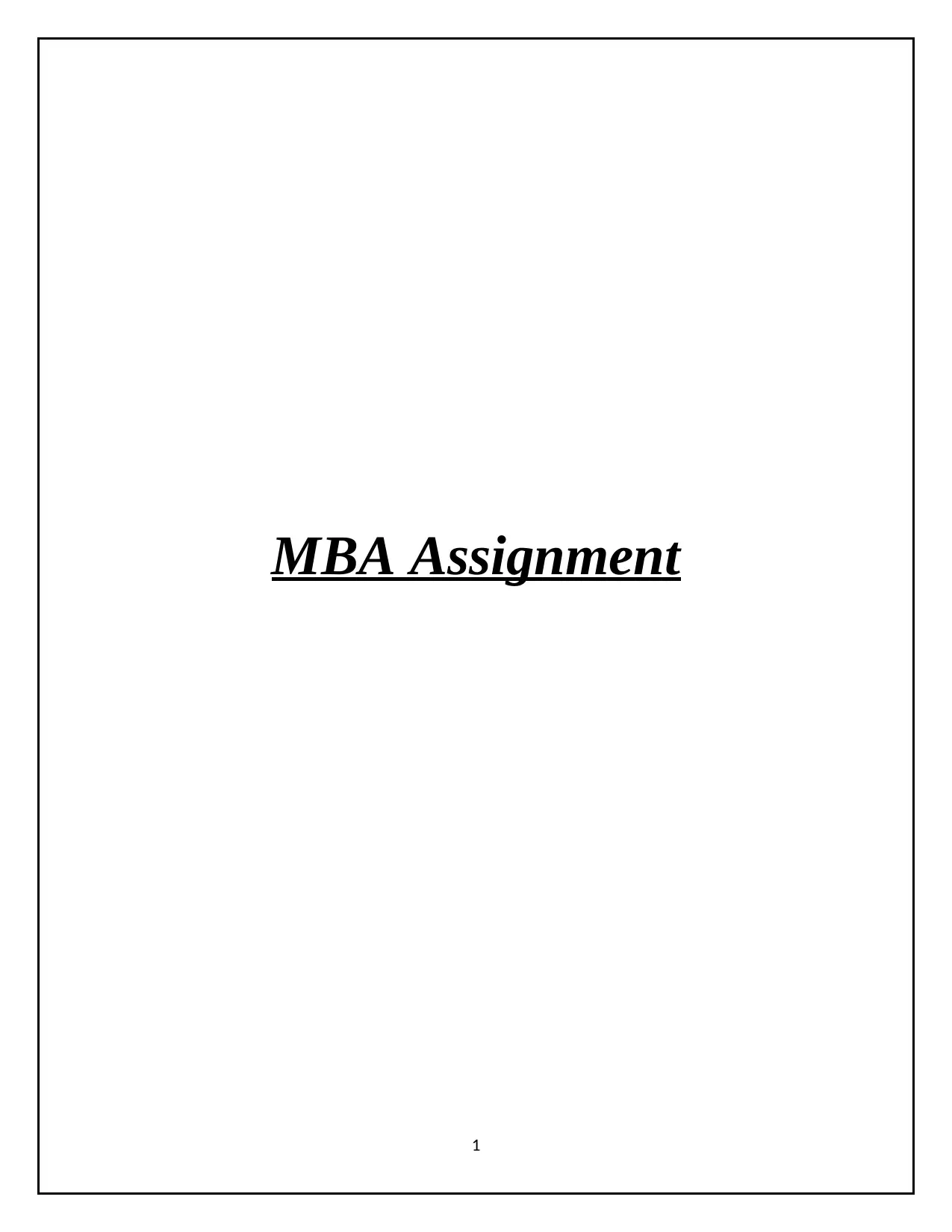
MBA Assignment
1
1
Paraphrase This Document
Need a fresh take? Get an instant paraphrase of this document with our AI Paraphraser
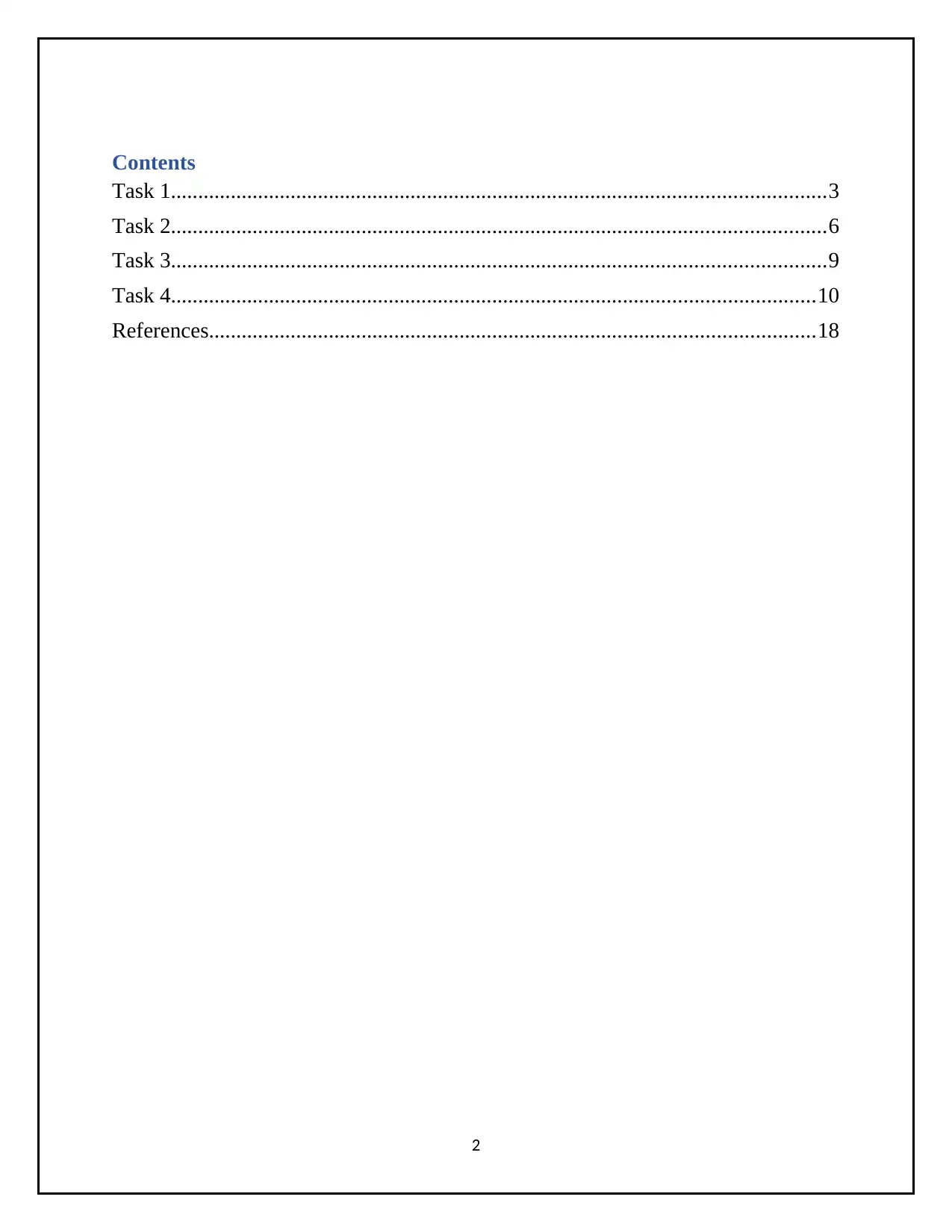
Contents
Task 1........................................................................................................................3
Task 2........................................................................................................................6
Task 3........................................................................................................................9
Task 4......................................................................................................................10
References...............................................................................................................18
2
Task 1........................................................................................................................3
Task 2........................................................................................................................6
Task 3........................................................................................................................9
Task 4......................................................................................................................10
References...............................................................................................................18
2
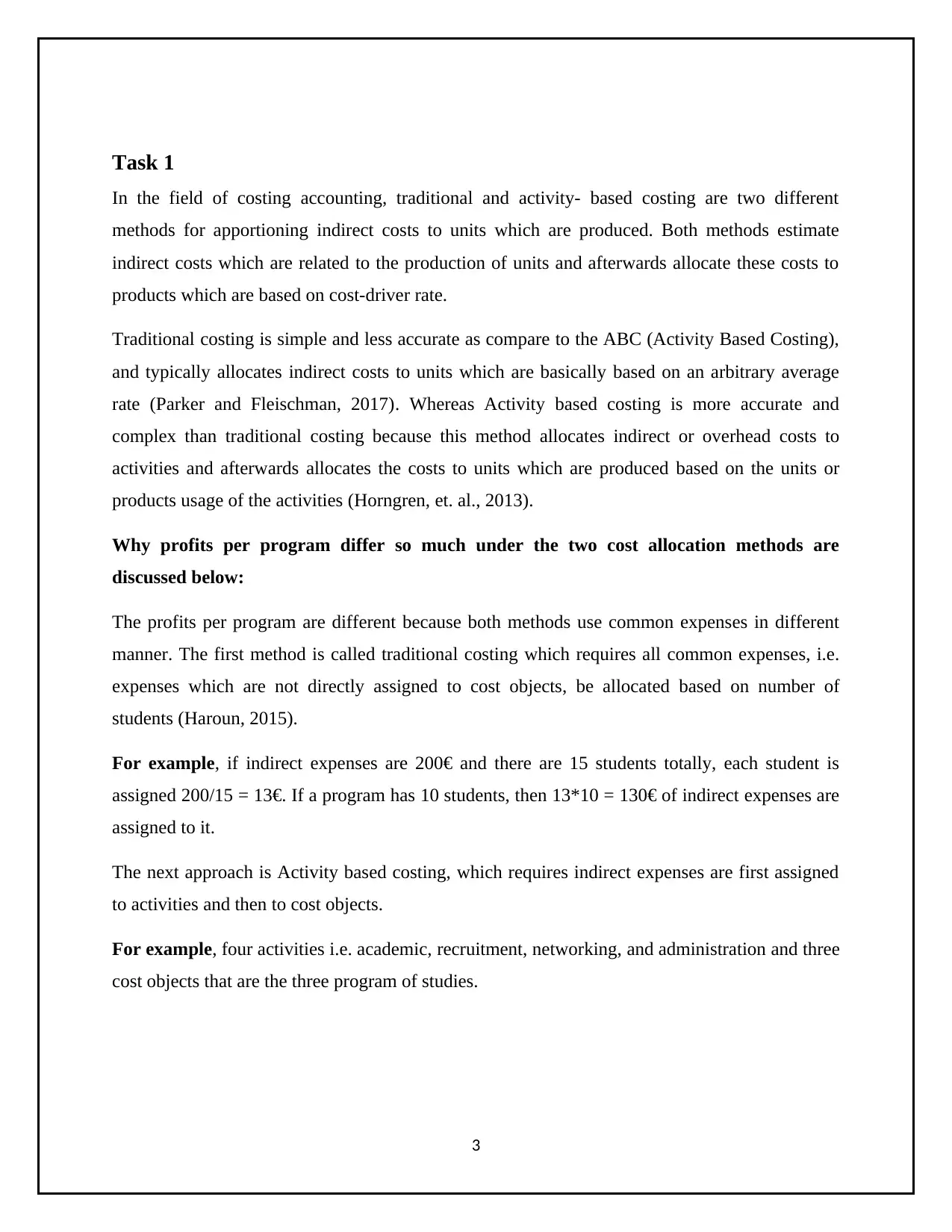
Task 1
In the field of costing accounting, traditional and activity- based costing are two different
methods for apportioning indirect costs to units which are produced. Both methods estimate
indirect costs which are related to the production of units and afterwards allocate these costs to
products which are based on cost-driver rate.
Traditional costing is simple and less accurate as compare to the ABC (Activity Based Costing),
and typically allocates indirect costs to units which are basically based on an arbitrary average
rate (Parker and Fleischman, 2017). Whereas Activity based costing is more accurate and
complex than traditional costing because this method allocates indirect or overhead costs to
activities and afterwards allocates the costs to units which are produced based on the units or
products usage of the activities (Horngren, et. al., 2013).
Why profits per program differ so much under the two cost allocation methods are
discussed below:
The profits per program are different because both methods use common expenses in different
manner. The first method is called traditional costing which requires all common expenses, i.e.
expenses which are not directly assigned to cost objects, be allocated based on number of
students (Haroun, 2015).
For example, if indirect expenses are 200€ and there are 15 students totally, each student is
assigned 200/15 = 13€. If a program has 10 students, then 13*10 = 130€ of indirect expenses are
assigned to it.
The next approach is Activity based costing, which requires indirect expenses are first assigned
to activities and then to cost objects.
For example, four activities i.e. academic, recruitment, networking, and administration and three
cost objects that are the three program of studies.
3
In the field of costing accounting, traditional and activity- based costing are two different
methods for apportioning indirect costs to units which are produced. Both methods estimate
indirect costs which are related to the production of units and afterwards allocate these costs to
products which are based on cost-driver rate.
Traditional costing is simple and less accurate as compare to the ABC (Activity Based Costing),
and typically allocates indirect costs to units which are basically based on an arbitrary average
rate (Parker and Fleischman, 2017). Whereas Activity based costing is more accurate and
complex than traditional costing because this method allocates indirect or overhead costs to
activities and afterwards allocates the costs to units which are produced based on the units or
products usage of the activities (Horngren, et. al., 2013).
Why profits per program differ so much under the two cost allocation methods are
discussed below:
The profits per program are different because both methods use common expenses in different
manner. The first method is called traditional costing which requires all common expenses, i.e.
expenses which are not directly assigned to cost objects, be allocated based on number of
students (Haroun, 2015).
For example, if indirect expenses are 200€ and there are 15 students totally, each student is
assigned 200/15 = 13€. If a program has 10 students, then 13*10 = 130€ of indirect expenses are
assigned to it.
The next approach is Activity based costing, which requires indirect expenses are first assigned
to activities and then to cost objects.
For example, four activities i.e. academic, recruitment, networking, and administration and three
cost objects that are the three program of studies.
3
⊘ This is a preview!⊘
Do you want full access?
Subscribe today to unlock all pages.

Trusted by 1+ million students worldwide
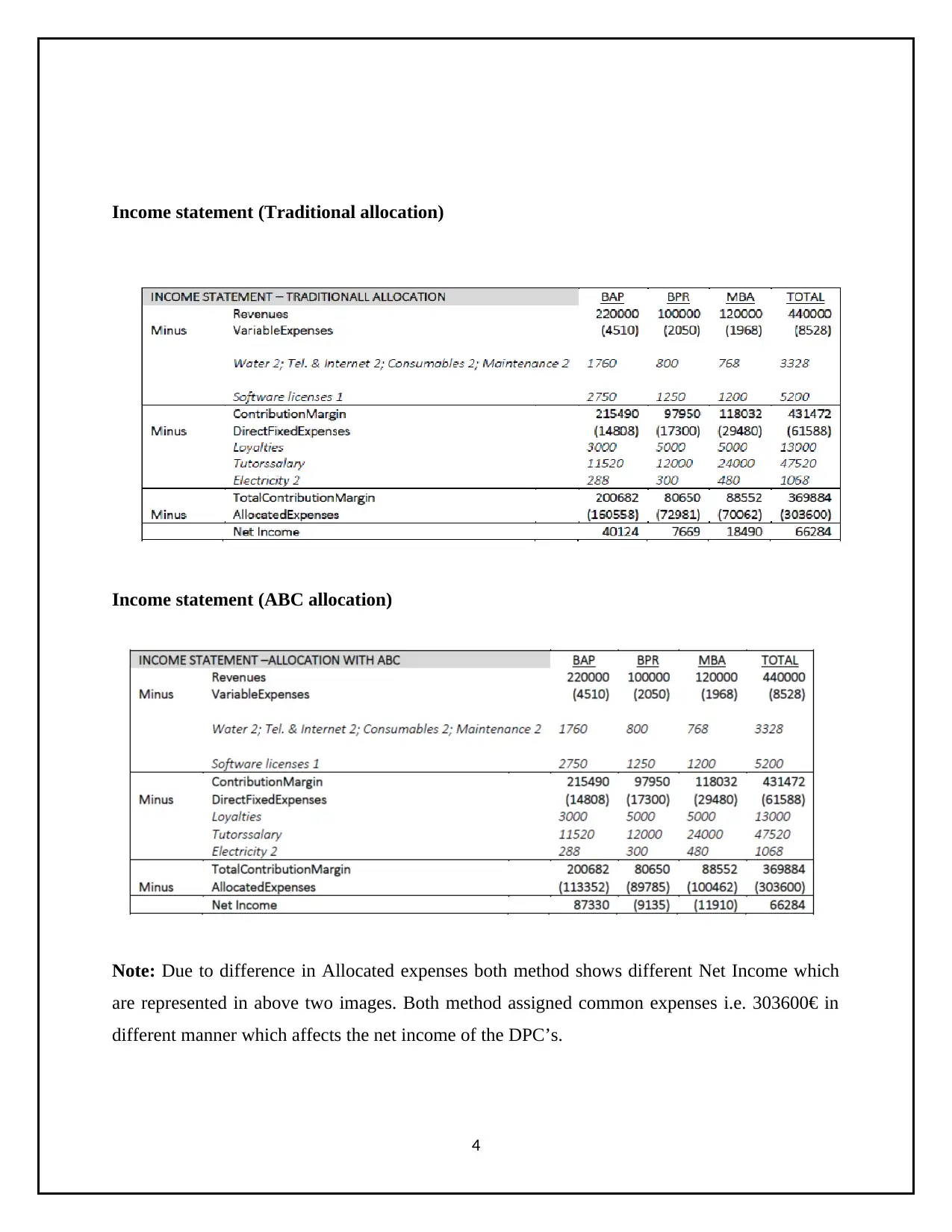
Income statement (Traditional allocation)
Income statement (ABC allocation)
Note: Due to difference in Allocated expenses both method shows different Net Income which
are represented in above two images. Both method assigned common expenses i.e. 303600€ in
different manner which affects the net income of the DPC’s.
4
Income statement (ABC allocation)
Note: Due to difference in Allocated expenses both method shows different Net Income which
are represented in above two images. Both method assigned common expenses i.e. 303600€ in
different manner which affects the net income of the DPC’s.
4
Paraphrase This Document
Need a fresh take? Get an instant paraphrase of this document with our AI Paraphraser
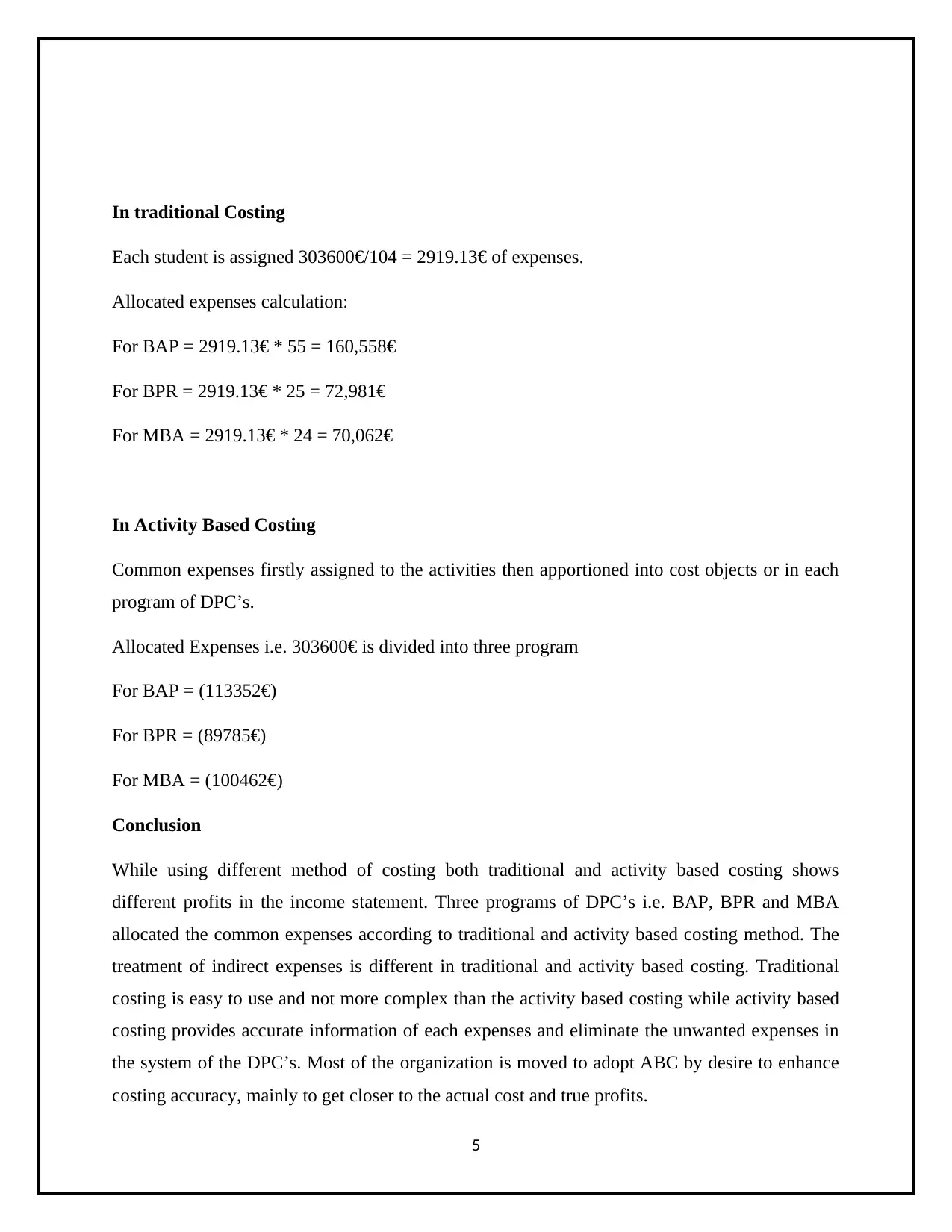
In traditional Costing
Each student is assigned 303600€/104 = 2919.13€ of expenses.
Allocated expenses calculation:
For BAP = 2919.13€ * 55 = 160,558€
For BPR = 2919.13€ * 25 = 72,981€
For MBA = 2919.13€ * 24 = 70,062€
In Activity Based Costing
Common expenses firstly assigned to the activities then apportioned into cost objects or in each
program of DPC’s.
Allocated Expenses i.e. 303600€ is divided into three program
For BAP = (113352€)
For BPR = (89785€)
For MBA = (100462€)
Conclusion
While using different method of costing both traditional and activity based costing shows
different profits in the income statement. Three programs of DPC’s i.e. BAP, BPR and MBA
allocated the common expenses according to traditional and activity based costing method. The
treatment of indirect expenses is different in traditional and activity based costing. Traditional
costing is easy to use and not more complex than the activity based costing while activity based
costing provides accurate information of each expenses and eliminate the unwanted expenses in
the system of the DPC’s. Most of the organization is moved to adopt ABC by desire to enhance
costing accuracy, mainly to get closer to the actual cost and true profits.
5
Each student is assigned 303600€/104 = 2919.13€ of expenses.
Allocated expenses calculation:
For BAP = 2919.13€ * 55 = 160,558€
For BPR = 2919.13€ * 25 = 72,981€
For MBA = 2919.13€ * 24 = 70,062€
In Activity Based Costing
Common expenses firstly assigned to the activities then apportioned into cost objects or in each
program of DPC’s.
Allocated Expenses i.e. 303600€ is divided into three program
For BAP = (113352€)
For BPR = (89785€)
For MBA = (100462€)
Conclusion
While using different method of costing both traditional and activity based costing shows
different profits in the income statement. Three programs of DPC’s i.e. BAP, BPR and MBA
allocated the common expenses according to traditional and activity based costing method. The
treatment of indirect expenses is different in traditional and activity based costing. Traditional
costing is easy to use and not more complex than the activity based costing while activity based
costing provides accurate information of each expenses and eliminate the unwanted expenses in
the system of the DPC’s. Most of the organization is moved to adopt ABC by desire to enhance
costing accuracy, mainly to get closer to the actual cost and true profits.
5

6
⊘ This is a preview!⊘
Do you want full access?
Subscribe today to unlock all pages.

Trusted by 1+ million students worldwide
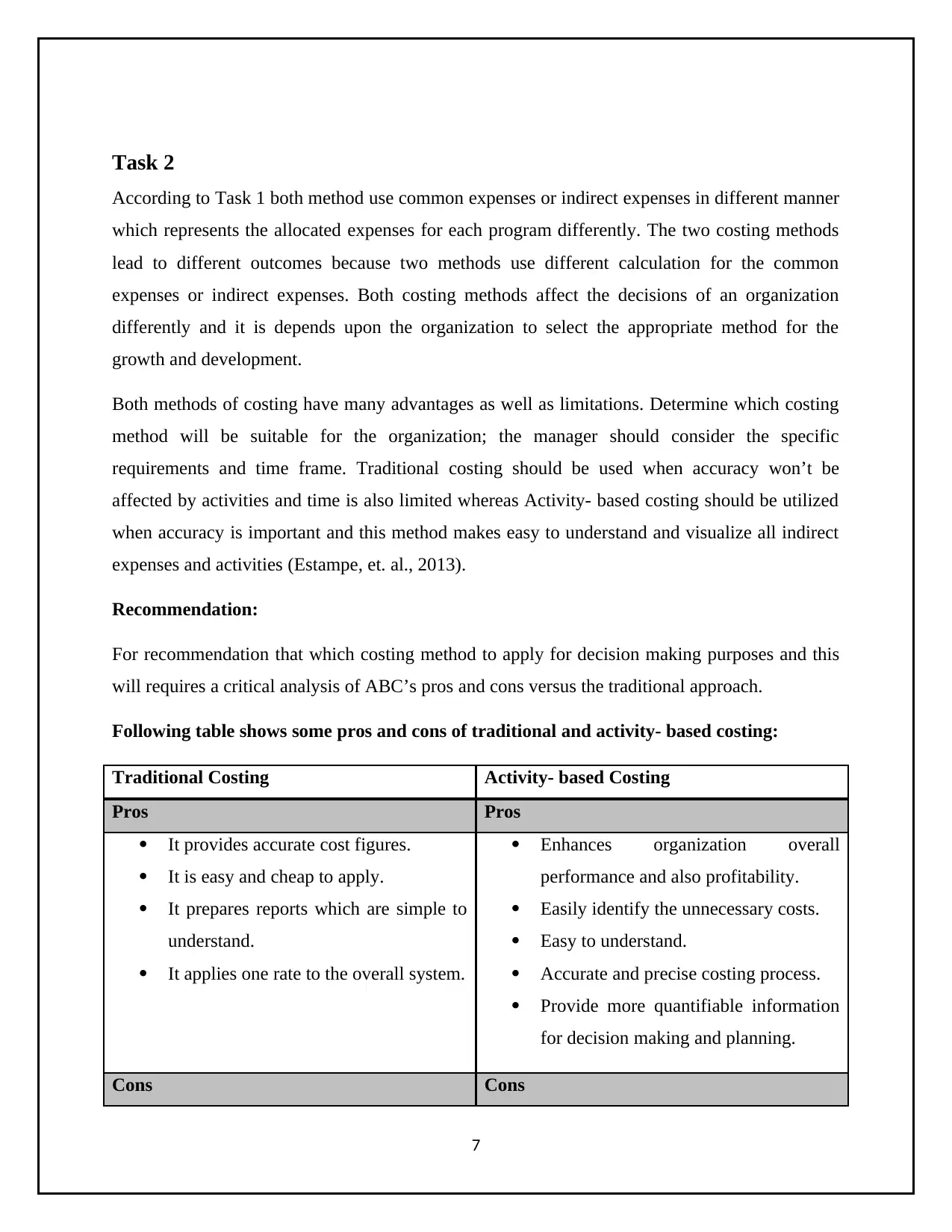
Task 2
According to Task 1 both method use common expenses or indirect expenses in different manner
which represents the allocated expenses for each program differently. The two costing methods
lead to different outcomes because two methods use different calculation for the common
expenses or indirect expenses. Both costing methods affect the decisions of an organization
differently and it is depends upon the organization to select the appropriate method for the
growth and development.
Both methods of costing have many advantages as well as limitations. Determine which costing
method will be suitable for the organization; the manager should consider the specific
requirements and time frame. Traditional costing should be used when accuracy won’t be
affected by activities and time is also limited whereas Activity- based costing should be utilized
when accuracy is important and this method makes easy to understand and visualize all indirect
expenses and activities (Estampe, et. al., 2013).
Recommendation:
For recommendation that which costing method to apply for decision making purposes and this
will requires a critical analysis of ABC’s pros and cons versus the traditional approach.
Following table shows some pros and cons of traditional and activity- based costing:
Traditional Costing Activity- based Costing
Pros Pros
It provides accurate cost figures.
It is easy and cheap to apply.
It prepares reports which are simple to
understand.
It applies one rate to the overall system.
Enhances organization overall
performance and also profitability.
Easily identify the unnecessary costs.
Easy to understand.
Accurate and precise costing process.
Provide more quantifiable information
for decision making and planning.
Cons Cons
7
According to Task 1 both method use common expenses or indirect expenses in different manner
which represents the allocated expenses for each program differently. The two costing methods
lead to different outcomes because two methods use different calculation for the common
expenses or indirect expenses. Both costing methods affect the decisions of an organization
differently and it is depends upon the organization to select the appropriate method for the
growth and development.
Both methods of costing have many advantages as well as limitations. Determine which costing
method will be suitable for the organization; the manager should consider the specific
requirements and time frame. Traditional costing should be used when accuracy won’t be
affected by activities and time is also limited whereas Activity- based costing should be utilized
when accuracy is important and this method makes easy to understand and visualize all indirect
expenses and activities (Estampe, et. al., 2013).
Recommendation:
For recommendation that which costing method to apply for decision making purposes and this
will requires a critical analysis of ABC’s pros and cons versus the traditional approach.
Following table shows some pros and cons of traditional and activity- based costing:
Traditional Costing Activity- based Costing
Pros Pros
It provides accurate cost figures.
It is easy and cheap to apply.
It prepares reports which are simple to
understand.
It applies one rate to the overall system.
Enhances organization overall
performance and also profitability.
Easily identify the unnecessary costs.
Easy to understand.
Accurate and precise costing process.
Provide more quantifiable information
for decision making and planning.
Cons Cons
7
Paraphrase This Document
Need a fresh take? Get an instant paraphrase of this document with our AI Paraphraser
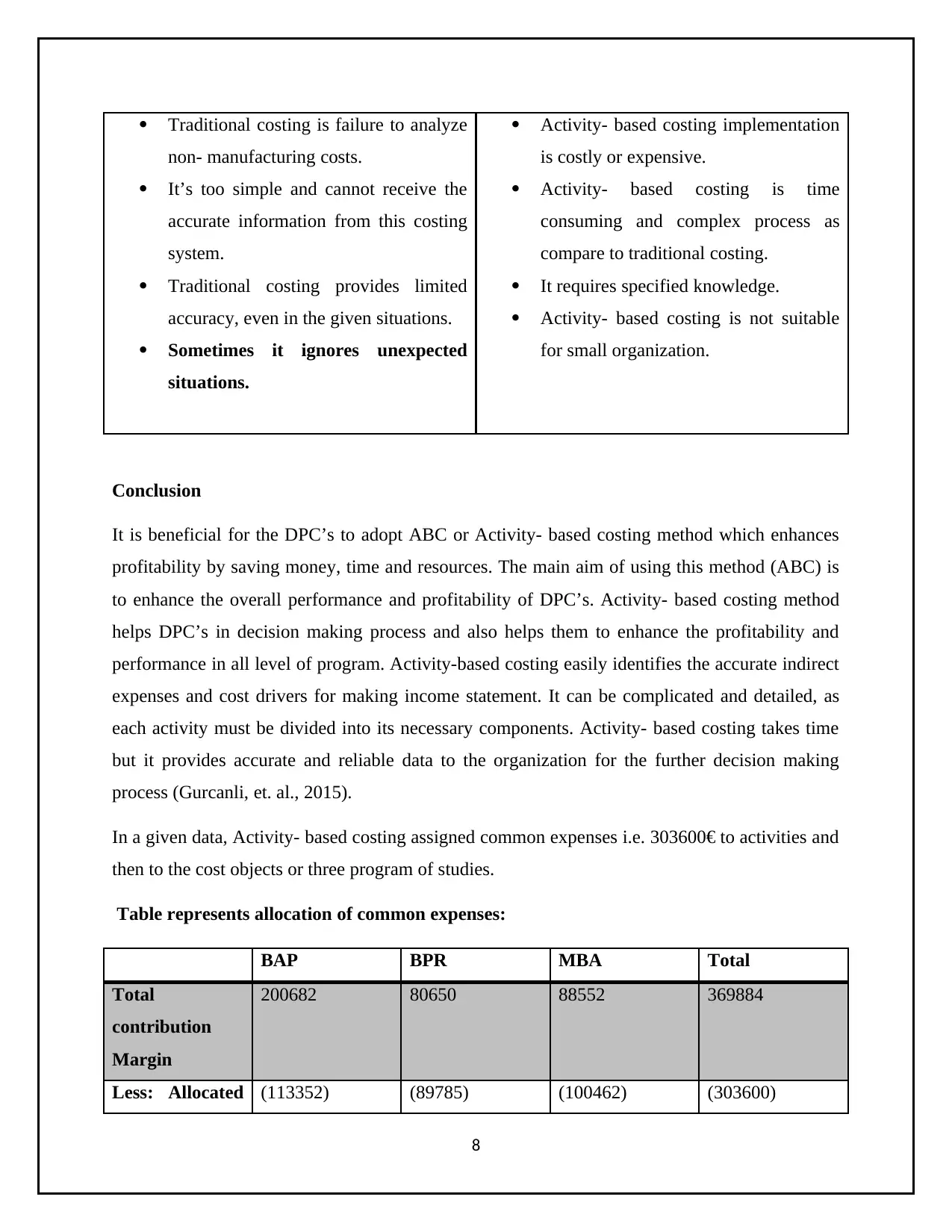
Traditional costing is failure to analyze
non- manufacturing costs.
It’s too simple and cannot receive the
accurate information from this costing
system.
Traditional costing provides limited
accuracy, even in the given situations.
Sometimes it ignores unexpected
situations.
Activity- based costing implementation
is costly or expensive.
Activity- based costing is time
consuming and complex process as
compare to traditional costing.
It requires specified knowledge.
Activity- based costing is not suitable
for small organization.
Conclusion
It is beneficial for the DPC’s to adopt ABC or Activity- based costing method which enhances
profitability by saving money, time and resources. The main aim of using this method (ABC) is
to enhance the overall performance and profitability of DPC’s. Activity- based costing method
helps DPC’s in decision making process and also helps them to enhance the profitability and
performance in all level of program. Activity-based costing easily identifies the accurate indirect
expenses and cost drivers for making income statement. It can be complicated and detailed, as
each activity must be divided into its necessary components. Activity- based costing takes time
but it provides accurate and reliable data to the organization for the further decision making
process (Gurcanli, et. al., 2015).
In a given data, Activity- based costing assigned common expenses i.e. 303600€ to activities and
then to the cost objects or three program of studies.
Table represents allocation of common expenses:
BAP BPR MBA Total
Total
contribution
Margin
200682 80650 88552 369884
Less: Allocated (113352) (89785) (100462) (303600)
8
non- manufacturing costs.
It’s too simple and cannot receive the
accurate information from this costing
system.
Traditional costing provides limited
accuracy, even in the given situations.
Sometimes it ignores unexpected
situations.
Activity- based costing implementation
is costly or expensive.
Activity- based costing is time
consuming and complex process as
compare to traditional costing.
It requires specified knowledge.
Activity- based costing is not suitable
for small organization.
Conclusion
It is beneficial for the DPC’s to adopt ABC or Activity- based costing method which enhances
profitability by saving money, time and resources. The main aim of using this method (ABC) is
to enhance the overall performance and profitability of DPC’s. Activity- based costing method
helps DPC’s in decision making process and also helps them to enhance the profitability and
performance in all level of program. Activity-based costing easily identifies the accurate indirect
expenses and cost drivers for making income statement. It can be complicated and detailed, as
each activity must be divided into its necessary components. Activity- based costing takes time
but it provides accurate and reliable data to the organization for the further decision making
process (Gurcanli, et. al., 2015).
In a given data, Activity- based costing assigned common expenses i.e. 303600€ to activities and
then to the cost objects or three program of studies.
Table represents allocation of common expenses:
BAP BPR MBA Total
Total
contribution
Margin
200682 80650 88552 369884
Less: Allocated (113352) (89785) (100462) (303600)
8

expenses
Net Income 87330 (9135) (11910) 66284
9
Net Income 87330 (9135) (11910) 66284
9
⊘ This is a preview!⊘
Do you want full access?
Subscribe today to unlock all pages.

Trusted by 1+ million students worldwide
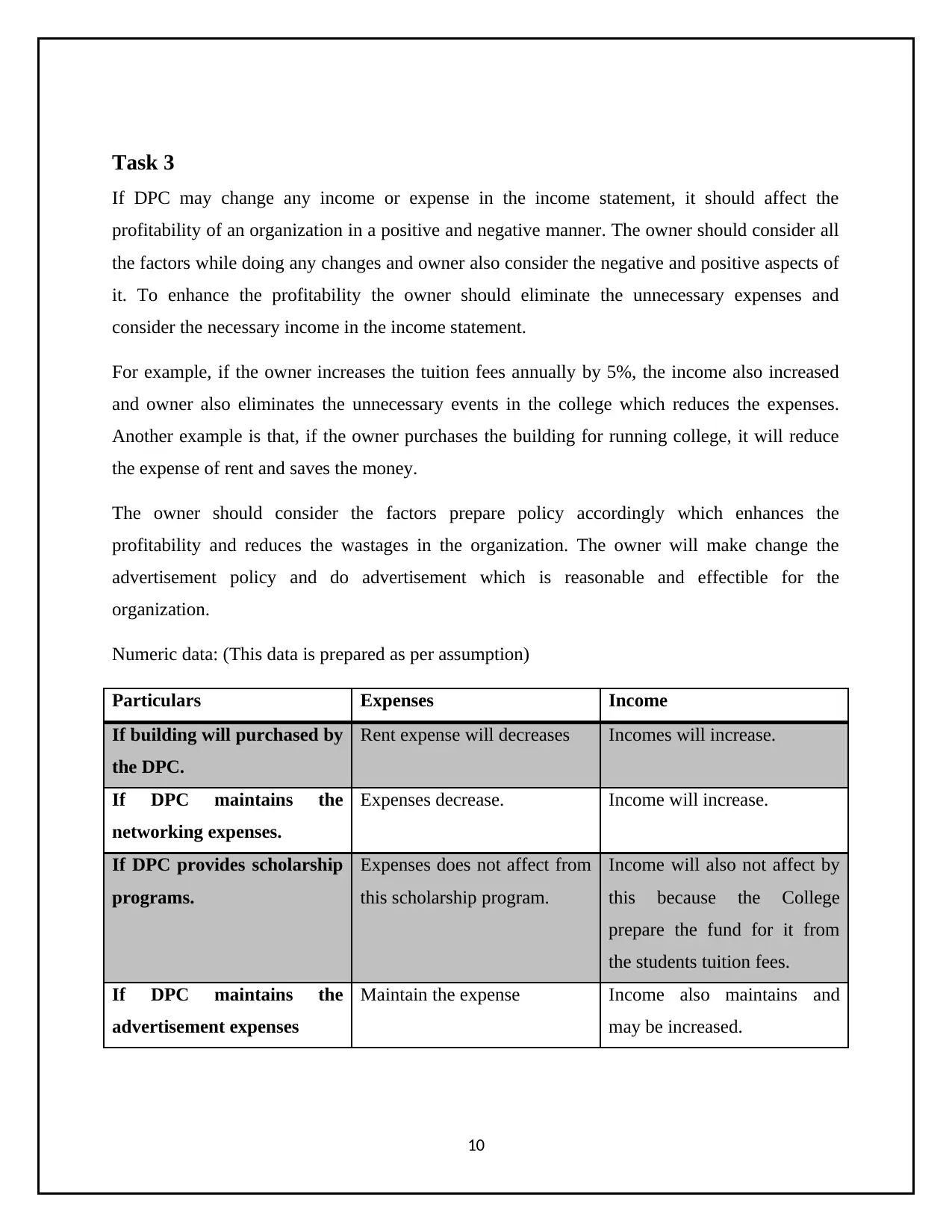
Task 3
If DPC may change any income or expense in the income statement, it should affect the
profitability of an organization in a positive and negative manner. The owner should consider all
the factors while doing any changes and owner also consider the negative and positive aspects of
it. To enhance the profitability the owner should eliminate the unnecessary expenses and
consider the necessary income in the income statement.
For example, if the owner increases the tuition fees annually by 5%, the income also increased
and owner also eliminates the unnecessary events in the college which reduces the expenses.
Another example is that, if the owner purchases the building for running college, it will reduce
the expense of rent and saves the money.
The owner should consider the factors prepare policy accordingly which enhances the
profitability and reduces the wastages in the organization. The owner will make change the
advertisement policy and do advertisement which is reasonable and effectible for the
organization.
Numeric data: (This data is prepared as per assumption)
Particulars Expenses Income
If building will purchased by
the DPC.
Rent expense will decreases Incomes will increase.
If DPC maintains the
networking expenses.
Expenses decrease. Income will increase.
If DPC provides scholarship
programs.
Expenses does not affect from
this scholarship program.
Income will also not affect by
this because the College
prepare the fund for it from
the students tuition fees.
If DPC maintains the
advertisement expenses
Maintain the expense Income also maintains and
may be increased.
10
If DPC may change any income or expense in the income statement, it should affect the
profitability of an organization in a positive and negative manner. The owner should consider all
the factors while doing any changes and owner also consider the negative and positive aspects of
it. To enhance the profitability the owner should eliminate the unnecessary expenses and
consider the necessary income in the income statement.
For example, if the owner increases the tuition fees annually by 5%, the income also increased
and owner also eliminates the unnecessary events in the college which reduces the expenses.
Another example is that, if the owner purchases the building for running college, it will reduce
the expense of rent and saves the money.
The owner should consider the factors prepare policy accordingly which enhances the
profitability and reduces the wastages in the organization. The owner will make change the
advertisement policy and do advertisement which is reasonable and effectible for the
organization.
Numeric data: (This data is prepared as per assumption)
Particulars Expenses Income
If building will purchased by
the DPC.
Rent expense will decreases Incomes will increase.
If DPC maintains the
networking expenses.
Expenses decrease. Income will increase.
If DPC provides scholarship
programs.
Expenses does not affect from
this scholarship program.
Income will also not affect by
this because the College
prepare the fund for it from
the students tuition fees.
If DPC maintains the
advertisement expenses
Maintain the expense Income also maintains and
may be increased.
10
Paraphrase This Document
Need a fresh take? Get an instant paraphrase of this document with our AI Paraphraser
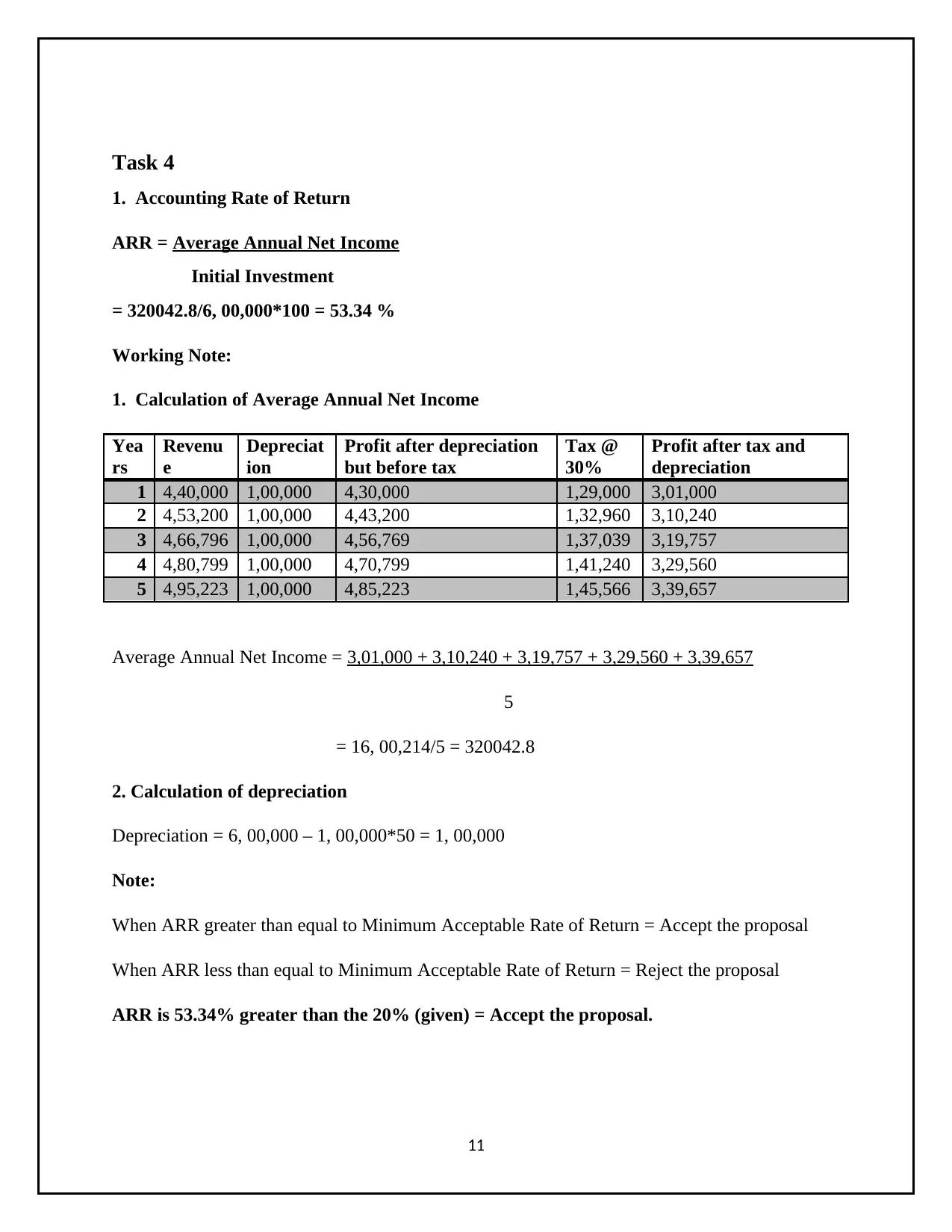
Task 4
1. Accounting Rate of Return
ARR = Average Annual Net Income
Initial Investment
= 320042.8/6, 00,000*100 = 53.34 %
Working Note:
1. Calculation of Average Annual Net Income
Yea
rs
Revenu
e
Depreciat
ion
Profit after depreciation
but before tax
Tax @
30%
Profit after tax and
depreciation
1 4,40,000 1,00,000 4,30,000 1,29,000 3,01,000
2 4,53,200 1,00,000 4,43,200 1,32,960 3,10,240
3 4,66,796 1,00,000 4,56,769 1,37,039 3,19,757
4 4,80,799 1,00,000 4,70,799 1,41,240 3,29,560
5 4,95,223 1,00,000 4,85,223 1,45,566 3,39,657
Average Annual Net Income = 3,01,000 + 3,10,240 + 3,19,757 + 3,29,560 + 3,39,657
5
= 16, 00,214/5 = 320042.8
2. Calculation of depreciation
Depreciation = 6, 00,000 – 1, 00,000*50 = 1, 00,000
Note:
When ARR greater than equal to Minimum Acceptable Rate of Return = Accept the proposal
When ARR less than equal to Minimum Acceptable Rate of Return = Reject the proposal
ARR is 53.34% greater than the 20% (given) = Accept the proposal.
11
1. Accounting Rate of Return
ARR = Average Annual Net Income
Initial Investment
= 320042.8/6, 00,000*100 = 53.34 %
Working Note:
1. Calculation of Average Annual Net Income
Yea
rs
Revenu
e
Depreciat
ion
Profit after depreciation
but before tax
Tax @
30%
Profit after tax and
depreciation
1 4,40,000 1,00,000 4,30,000 1,29,000 3,01,000
2 4,53,200 1,00,000 4,43,200 1,32,960 3,10,240
3 4,66,796 1,00,000 4,56,769 1,37,039 3,19,757
4 4,80,799 1,00,000 4,70,799 1,41,240 3,29,560
5 4,95,223 1,00,000 4,85,223 1,45,566 3,39,657
Average Annual Net Income = 3,01,000 + 3,10,240 + 3,19,757 + 3,29,560 + 3,39,657
5
= 16, 00,214/5 = 320042.8
2. Calculation of depreciation
Depreciation = 6, 00,000 – 1, 00,000*50 = 1, 00,000
Note:
When ARR greater than equal to Minimum Acceptable Rate of Return = Accept the proposal
When ARR less than equal to Minimum Acceptable Rate of Return = Reject the proposal
ARR is 53.34% greater than the 20% (given) = Accept the proposal.
11
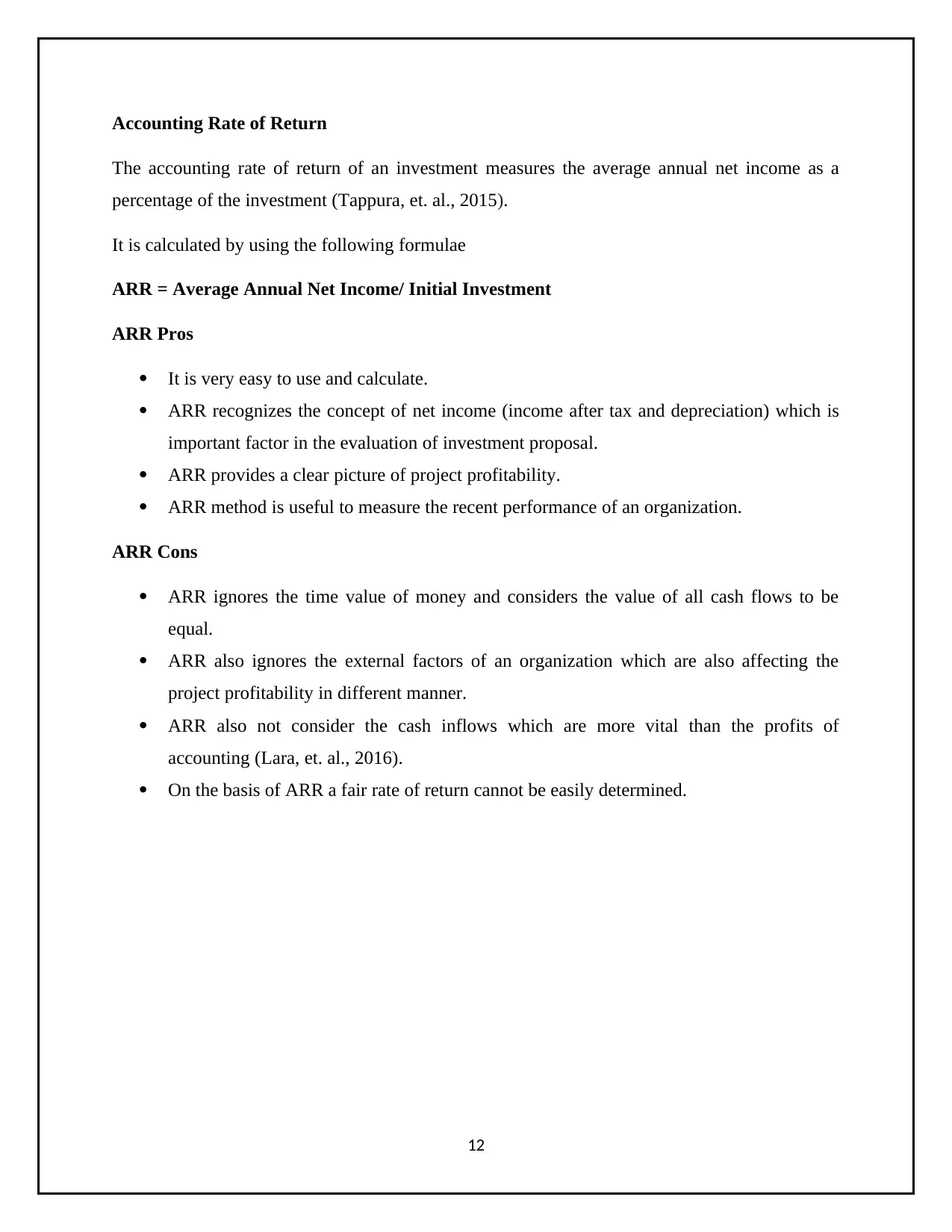
Accounting Rate of Return
The accounting rate of return of an investment measures the average annual net income as a
percentage of the investment (Tappura, et. al., 2015).
It is calculated by using the following formulae
ARR = Average Annual Net Income/ Initial Investment
ARR Pros
It is very easy to use and calculate.
ARR recognizes the concept of net income (income after tax and depreciation) which is
important factor in the evaluation of investment proposal.
ARR provides a clear picture of project profitability.
ARR method is useful to measure the recent performance of an organization.
ARR Cons
ARR ignores the time value of money and considers the value of all cash flows to be
equal.
ARR also ignores the external factors of an organization which are also affecting the
project profitability in different manner.
ARR also not consider the cash inflows which are more vital than the profits of
accounting (Lara, et. al., 2016).
On the basis of ARR a fair rate of return cannot be easily determined.
12
The accounting rate of return of an investment measures the average annual net income as a
percentage of the investment (Tappura, et. al., 2015).
It is calculated by using the following formulae
ARR = Average Annual Net Income/ Initial Investment
ARR Pros
It is very easy to use and calculate.
ARR recognizes the concept of net income (income after tax and depreciation) which is
important factor in the evaluation of investment proposal.
ARR provides a clear picture of project profitability.
ARR method is useful to measure the recent performance of an organization.
ARR Cons
ARR ignores the time value of money and considers the value of all cash flows to be
equal.
ARR also ignores the external factors of an organization which are also affecting the
project profitability in different manner.
ARR also not consider the cash inflows which are more vital than the profits of
accounting (Lara, et. al., 2016).
On the basis of ARR a fair rate of return cannot be easily determined.
12
⊘ This is a preview!⊘
Do you want full access?
Subscribe today to unlock all pages.

Trusted by 1+ million students worldwide
1 out of 20
Related Documents
Your All-in-One AI-Powered Toolkit for Academic Success.
+13062052269
info@desklib.com
Available 24*7 on WhatsApp / Email
![[object Object]](/_next/static/media/star-bottom.7253800d.svg)
Unlock your academic potential
Copyright © 2020–2025 A2Z Services. All Rights Reserved. Developed and managed by ZUCOL.




